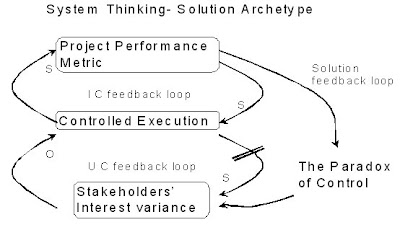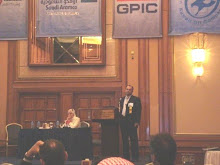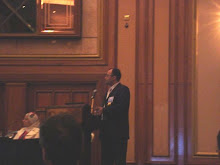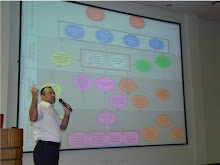Our assessment of the common strategic planning processes has uncovered the need to introduce more strategic planners into the strategy making process which is currently owned by line managers and performed in a synthetic manner- below the threshold of “formalization edge”- a good practice. (Mintzberg H., 2004)
Strategic planners will enrich the strategy making process with analytical formal insights and the strategy implementation process with strategic programming scheme (including codification, elaboration and conversion of strategies).
Heading towards a more flexible learning organization, we would favor including more “left-handed” planners to uncover strategies in strange places and serve as stimulating catalysts. (March J. et al., 1976)
Organizations can espouse the comprehensive framework presented in fig. below (integrating planning, plans and planners’ roles) then tailor it to our specific needs (Mintzberg H., 1987)
Figure 2: strategic planning framework adopted from Mintzberg, 2004
About The Author

- Eng. Samer el Barakeh, MPM, PMP
- Samer el Barakeh was born in Lebanon, 1973. He completed his Bachelor in Engineering-CCE at Beirut Arab University-Lebanon in 1996 with honours. Samer was granted Masters Degree in Project Management (MPM) from the University of Sydney-Australia with honours. He also gained the Project Management Professional (PMP) Credential from The Project Management Institute (PMI). Samer is a member of the Order of Architects and Engineers in Lebanon since 1996, The Project Management Institute (PMI), Arabian Gulf Chapter (AGC-PMI) and Lebanon Chapter-PMI. During his 13 years of professional experience in Lebanon, Australia and Saudi Arabia, Samer held many positions among them: Telecommunication Site Engineer, Site Manager, Low Current Service Head, and he is currently Senior Systems Analyst at the General Project Construction Division. Samer is a Project Management Consultant and Training Provider for universal organizations like Business Management Consultants (USA) www.bmc-online.com and PMCTQuest (Canada) www.pmctquest.com Samer is a Registered Training Provider for Project Management Professional (PMP), and he provides training in Program Management, Portfolio Management,PMO...
Select a topic to view content
- A comparison between PMBOK and Prince2 Methodologies and reflection on case study examples (1)
- ABC to Avoid Project Failure (1)
- Business Case and Quantitative Benefits (1)
- Do we need more 'Planners' ? (1)
- Fasilitator in Partnering-A Coincise Shot (1)
- How to Ensure Stratgic Alignment of Our Projects? (1)
- Individual Dissimilarity and Team Work (1)
- Knowledge Management (1)
- Maturity Models-The Pros and Cons (1)
- Organizational Advantages from Partnering (1)
- Organizational Maturity: Lets Head Upwards... (1)
- Organizational Strategy and Project Alignement (1)
- Practical Solutions 1 of 6: Introduce RMMM (1)
- Practical Solutions 2 of 6: Facilitate Change to Perk up Maturity (1)
- Practical Solutions 3 of 6: Leverage Organisational Culture Barrier (1)
- Practical Solutions 4 of 6: Organisational Cultural Alignment (1)
- Practical Solutions 5 of 6: Defining a Unified Decision Making Tool (1)
- Practical Solutions 6 of 6: Understanding The Paradox of Control (1)
- Programme Management to Implement Strategy (1)
- Project Management and Construction Management (1)
- Project Managers relocated before Proper Project Closure and Learning Lessons (1)
- Project Managers' Power (1)
- Strategic Planning (1)
- Successful Project Management Office-PMO (1)
- System Thinking: Archetypes at Work... (1)
- The Partnering Change Process (1)
- The Upper Hand… Leadership skills or Processes? (1)
- Thinking about change needed? Maybe you should be more ‘worried’ about how to make it real (1)
- Vision Mission and Objectives What and Why? (1)
- What is meant by Portfolio and Programme Management (1)
- Why Partnering in Organizations? (1)
December 30, 2007
Strategic Planning, Do we need more 'Planners' ?
Posted by
Eng. Samer el Barakeh, MPM, PMP
at
2:28 PM
0
comments
![]()
![]()
Organizational Maturity: Lets Head Upwards!
Maturity reflects the current organizational competencies/practices level. It reveals how successful this organization can be in effectively running business and carrying out projects. The Six Stage Maturity Model (fig. 1) is based on the following six stages PMGT5876 (2004):
1. Foundation Stage
2. Garbage Can
3. Bureaucracy
4. Partnering
5. Empowerment
6. Network Organization

Figure 1: Six Stage Maturity Model
It is on this scale that organizations are assessed (1-6) according to the following eight criteria: Strategy, Management, Organization, Stakeholders, Contracts, Data, Systems and Processes and Technology.
While organizations develop, they progress through these stages. However the “strategic objectives” set by each organization will reflect its target upper maturity boundary.
As a complementary approach, since it is evident that Knowledge sharing is an essential pre-requisite for cultural developments, partnering, and alliance; therefore, we suggest adopting the RMMM (Relationship Management Maturity Model) that serves in aligning different units/divisions of the organization (Martin et al., 2006). It introduces a mechanism to bridge the cultural maturity gaps through an interpretive approach to knowledge sharing, defines knowledge sharing processes and emphasizes on the tasks of the “Relationship Managers” as facilitators of knowledge sharing and measuring the relationships’ maturities. The RMMM can furthermore be used to identify problematic issues and develop processes to address them.
These two maturity models should form the baseline of the change process in our organization upon which strategic decision and strategic change planning can build onwards.
Posted by
Eng. Samer el Barakeh, MPM, PMP
at
1:58 PM
0
comments
![]()
![]()
July 8, 2007
Practical Solutions 1 of 6: Introduce RMMM
We are going to introduce some practices that, when adequately implemented, can increase probability of successful project completion. They will be presented as:
- Being tested on a project we have recently performed
- Followed by recommended Post Project Reviews
--------------------------------------------------------------------
Introduce RMMM
After performing the assessment of current and target maturity levels for the project, maturity gaps were identified and strategies developed to leverage them.
In this aspect, we used the RMMM (Relationship Management Maturity Model) that served in aligning IT and business units of that project (Martin et al।, 2006). It did this via introducing a mechanism of an interpretive approach to knowledge processes between business and IT; then defining the tasks of the “Relationship Managers” as facilitators of knowledge sharing and measuring the maturity of the business/IT relation. The RMMM was furthermore used to identify problematic issues and develop processes to address them.
Post Project Review: We found that RMMM and relationship managers were effective; more alignment, open communication were evident and IT deliverables enabled realisation of business objectives. We recommend integrating this practice into our core processes for future solutions.
Posted by
Eng. Samer el Barakeh, MPM, PMP
at
8:00 PM
3
comments
![]()
![]()
July 7, 2007
Practical Solutions 2 of 6: Facilitate Change to Perk up Maturity
Facilitate Change to Perk up Maturity
With the many remaining gaps identified, the challenge of establishing a roadmap to move forward and leverage these gaps emerged. To do so, changes to project’s processes had to be developed and implemented.
In that case, as in many organizations, we were at different maturity levels in different Areas. Another implication introduced then was that immaturity in a knowledge area can affect success in others areas even if they were of high maturity levels (Duffy J., 2001).
A resolution to this challenge was to adopt IDC’s series of maturity models (International Data Corporation, Canada) where each maturity model (MM) is focused on the change associated with achieving excellence in managing key strategic business issues। The first four address the following issues:
- Customer Centricity;
- E-business Resilience;
- IT/Business Alignment (little work has to be done here as we have already addressed this gap by CMMM);
- IT Value, Metrics and Measurement.

Figure: Roadmap to Plan change, adopted from Duffy J., 2001
Post Project Review: The process had some shortages due to sensitivity that emerged during the self assessment process along with considerable time consumption along the implementation steps. We recommend using it only in case of ongoing developments rather than short span projects.
Posted by
Eng. Samer el Barakeh, MPM, PMP
at
8:25 PM
0
comments
![]()
![]()
Labels: Practical Solutions 2 of 6: Facilitate Change to Perk up Maturity
July 6, 2007
Practical Solutions 3 of 6: Leverage Organisational Culture Barrier
Organisational Culture Barrier
Organisational culture is in many cases a roadblock to project development as shown in figure below (Peppard and Ward, 1999). Consequently, other PM practices have to be developed in Parallel to and integrating with the RMMM in order to eliminate such a roadblock (Martin et al., 2006). 
We experienced a very effective strategy to leverage this roadblock by promoting a “Community of Practice” between the business and IT Units; where Wenger et al। (2002) describes it as a group of people that are bound together informally through sharing expertise and enthusiasm to achieve a target. CoP’s are driven by values, knowledge and know-how in contrast to traditional teams that are driven by deliverables and defined tasks. We witnessed efficient circulation of knowledge through the organization and a demolition of barriers between people and departments (Yang, 2004; Davenport and Prusak, 2004) as shown in figure below.
 Figure: Closing the business-IT gap adopted from Martin et al।, 2006।
Figure: Closing the business-IT gap adopted from Martin et al।, 2006।Post Project Review: Multi cultural teams with diversified backgrounds were more common and with CoP, it was not easy to build trust and rapport in a short time। We recommend more team building activities at the outset and developing smaller groups for less diversity.
Posted by
Eng. Samer el Barakeh, MPM, PMP
at
8:52 PM
0
comments
![]()
![]()
Labels: Practical Solutions 3 of 6: Leverage Organisational Culture Barrier
July 5, 2007
Practical Solutions 4 of 6: Organisational Cultural Alignment
A good, ample practice we sighted was that presented by Thompson and Sanders (1998); first, they identified different levels of involvement that are possible within partnerships and which they referred to as competition, cooperation, collaboration and coalescence. Then they presented a framework whereby differences and similarities in the cultures of partnering groups can be assessed and evaluated as shown in the following figure. The red line we drew identifies those cultural indicators where improvement strategies are required in order to increase the level of maturity and/or alignment and hence the probabilities of success for the partnership arrangement
 Figure 9: The Cultural maturity-Alignment
Figure 9: The Cultural maturity-Alignment
Posted by
Eng. Samer el Barakeh, MPM, PMP
at
6:29 PM
0
comments
![]()
![]()
Labels: Practical Solutions 4 of 6: Organisational Cultural Alignment
July 4, 2007
Practical Solutions 5 of 6: Defining a Unified Decision Making Tool
The next confront that faced our Project was to provide business and project managers with an open standard that can help them identify priorities and take decisions in a conscience way. To do so, a unified decision making tool was adopted. It reduced data at hand and enabled trouble-free reporting on performance. The Tool was based upon project measurement capabilities that already existed (Sevick, 2005).
A good example of the unified tool is the APdex formula (Application Performance Index) which sorts the assessment of end user satisfaction in an IT development into three categories:
- No of Satisfied users,
- No of tolerating users,
- No of frustrated users
The Apdex index can then be calculated using the following equation:
APdex = (Satisfied + (tolerating/2))/Total Samples
Developing this index for IT tasks provided senior management with common way to compare performance across all applications. We were then able to identify those practices that need improvements and gauge the effectiveness of improvement practices as well. However we had to factor in the importance of the process itself from a business perspective along with the unified Index.
Posted by
Eng. Samer el Barakeh, MPM, PMP
at
6:51 PM
0
comments
![]()
![]()
Labels: Practical Solutions 5 of 6: Defining a Unified Decision Making Tool
July 1, 2007
Practical Solutions 6 of 6: Understanding The Paradox of Control
Project’s control is a challenge. In our Project, we developed a rigid control process with metrics scattered over all project processes. Corrective actions were implemented whenever an indicator slipped outside accepted boundary. However, there was a decrease in sponsor’s satisfaction along the way. We performed a system thinking analysis to identify root causes and find best solutions as shown below Post Project Review: We learned that Project Manager must be vigilant in controlling the project outcomes in a prevailing climate of change and uncertainty.
Post Project Review: We learned that Project Manager must be vigilant in controlling the project outcomes in a prevailing climate of change and uncertainty.
While those affect both the Project Manager and other stakeholders, it was erroneous to expect the project to maintain delivering within agreed boundaries (STCQ) where predictable deviations from the plan are viewed by senior stakeholders as “out of control”.
The “zone” of middle management is bounded from the lower and upper sides by project managers and senior stakeholders respectively (shown in figure below). Project managers sense strategic directions/change by interacting with this zone. The prevailing assumption that this zone will always react to strategic management stimuli in the same way was here questioned! The reason to which is that the only certainty in the “zone” is unpredictability; Strategic and senior managers were made aware of this fact for future projects.
Project managers sense strategic directions/change by interacting with this zone. The prevailing assumption that this zone will always react to strategic management stimuli in the same way was here questioned! The reason to which is that the only certainty in the “zone” is unpredictability; Strategic and senior managers were made aware of this fact for future projects.
Controls comprise the craft of maintaining time, cost and quality by means of project control processes (process flow diagrams, responsibility activity matrix, QM, assessment criteria, KPIs and the like) along with the art of managing relationships with stakeholders and the forces they exerted in the “zone” (Theilen, 1999).
As a result, our Project managers gained a broader understanding of the three dimensions of control (figure below) and they comprehended that the “Control Process” is closely related to other Management Processes, like Stakeholder Management. 
Posted by
Eng. Samer el Barakeh, MPM, PMP
at
6:58 PM
0
comments
![]()
![]()
Labels: Practical Solutions 6 of 6: Understanding The Paradox of Control
May 30, 2007
The Upper Hand… Leadership skills or Processes?
Project success is more dependent on human factors (including Leadership) than technocratic processes (planning, procedures…)(Hauschildt, Keim and Medeof 2000). An assertion with many fans (Hull & Read, 2003; Lechler, 1988; Davies, 2002 to name but a few).
The Leadership-process-success link: "Leadership is influencing people to get things done to a standard and quality above their norm. And doing it willingly." (O'Neil, 2000) and “When it comes to project management, it’s the people that count” (Letchler T. 1998). Streaming down, numerous researches conducted since 1960’s, converged to 12 critical project success factors on which Davies declares “people perform every process; and its people who ultimately determine the adequacy. Thus the people side of the success factors is woven into their very fabric”. (Davies, IJoPM, 20 2002) (figure below)
From another perspective, whilst each process targets a specific project aspect as critical path competency gap would, at first glace, impacts project schedule/resources; whereas lack of Social Competency (EIC Standard) / Providing Leadership in the workplace (FMC Standard) would have a mega scale (multi-processes) impact on overall Project success.
I tend to vote for a complementary relationship। While methodologies and procedures form the 'framework'-hard dimension; Leadership symbolizes the 'art' (Dwight D. Eisenhower) that makes it perform optimally-soft dimension. (Figure below)

Regards,
Samer
Posted by
Eng. Samer el Barakeh, MPM, PMP
at
1:16 AM
2
comments
![]()
![]()
May 28, 2007
System Thinking: Archetypes at work!

Problem Archetype adopted from Wolstenholme, 2003
Solution to decrease impact of UC feedback loop: Applying system thinking approach to look at the big picture and problem context (PMGT6869, 2005)। A suggested solution archetype was developed to undermine the effect of Unintended Consequence feedback loop as shown below (Wolstenholme, 2003)
 Solution Archetype adopted from Wolstenholme, 2003
Solution Archetype adopted from Wolstenholme, 2003
Recommended Actions:

Learning from this experience: Future developments/proposals/solutions to proactively respond to prospective UC feedbacks.
In conclusion, the above mentioned actions were optimum। Applying them reduced the risks associated with this situation and enhanced desired results from multi-organisational teams’ establishment।
Samer
Posted by
Eng. Samer el Barakeh, MPM, PMP
at
6:40 PM
2
comments
![]()
![]()
Project Managers relocated before Proper Project Closure and Learning Lessons
The project manager, as an organizational resource will not be assigned to another project unless authorized by the Steering Committee that integrate specific criteria in such decision, including proper closure of the current project and capturing Lessons Learned.
Portfolio and Programme management provide some guidelines to such decisions. If we consider, as examples, the need of a qualified experienced PM in an ongoing project or the call for a quick initiation of project recently won in a bid, we can conclude that it is a matter of strategic organizational priorities.
I believe that the Learning Process is of equal importance throughout the project lifecycle and not only at the end. Lessons captured as we go are fed back into the ongoing project to improve productivity and realign. An example to that is the estimation process
(Estimate >> perform >> assess >> learn >> update buffer >> to estimate again), (PMGT6869, 2004). Unfortunately, more pressure comes upon on the learning process during initiation, planning and execution where the team is overwhelmed with performing and maintaining project within boundaries (STCQ) in the changing environment.
Another consideration, to be factored in, is that benefit realization plans mainly focus on “external client-related” project deliverables as bounded in the Business Case with less weight on internal benefits associated with learning. I have experienced many such cases in my organization.
The solution to the above mentioned issues is Knowledge Management (establishment, explicit formalization, planning and integration into the organizational culture) where learning lessons won’t be an ad-hoc mannered activity that can simply be “missed” if the PM is released from the project.
Finally, and to avoid reinventing the wheels, organizations should use previously tested blocks and available frameworks that can be tailored to our needs. In this regards, incorporating processes and practices from the AS, PMBoK, or other AIPM models should be supportive to improve organizational maturity in “learning”.
Regards,
Samer
Posted by
Eng. Samer el Barakeh, MPM, PMP
at
12:11 AM
0
comments
![]()
![]()
Labels: Project Managers relocated before Proper Project Closure and Learning Lessons
May 27, 2007
Knowledge Management
Starting with the definition, Knowledge Management includes a variety of practices aiming to identify, establish, represent, store and distribute knowledge that will afterwards be used for performing, awareness and learning within one organization and among different organisations। In many organisations, KM is embedded in IT or HRM (Vail III, 1999)
Organisational maturity varies with different knowledge areas। This reflects on KM by forming a vicious cycle where less maturity means less formalized processes and less organisational learning which in turn decreases organisational ability to improve maturity in that knowledge area. Thus organisations can avoid this by emphasising on capturing knowledge and organisational learning as a baseline.
Of equal importance to capturing knowledge throughout project lifecycle is the knowledge transfer। This starts with on-the-job peer discussions, formal apprenticeship, corporate libraries, professional training and mentoring programs then extends to IT based knowledge bases, expert systems and knowledge repositories.
I see that organisational learning and knowledge management are closely related, where both encounter “using the past to help us predict the future”. However, knowledge management gows a further step ahead of organisational learning by greater focus on specific knowledge assets and the development and cultivation of the channels through which knowledge flows. To promote KM, different organizations have tried various knowledge capture incentives, including making content submission mandatory and incorporating rewards into performance measurement plan.
A strategy to apply KM is to develop processes that enable us to successfully shift from “Tacit” to “Explicit” knowledge. That is, from subconscious internalized knowledge to formal, explicit knowledge that can be stored as an organisational asset and communicated among departments, units and projects (Monaka et al, 1995).
Knowledge Management provides a significant role in assisting PM’s decisions throughout the project phases when mature organisations provide systems, repositories, and corporate processes to encourage and formalize knowledge activities। PM’s access and capture knowledge via the following triple stage process:
First: During initiation and planning, learn best practice and lessons learned from similar projects undertaken earlier
Second: During implementation, tracking and control, to seek advice on issues or roadblocks encountered and how to handle them
Third: During project Closure, to seek advice on post project reviews and activities.
What if there was no previous advice of similar cases in the organisational database? An alternative option PM’s can rely on in KM is to access experts on an ad hoc basis with their knowledge requests। Some advantageous benefits of this option are:
- Experts provide quick, relevant and precise advice,
- They factor in all aspects of the situation and respond accordingly
Regards,
Samer
Posted by
Eng. Samer el Barakeh, MPM, PMP
at
7:07 PM
1 comments
![]()
![]()
Labels: Knowledge Management
A comparison between PMBOK and Prince2 Methodologies and reflection on case study examples
The PMBOK Guide, “The Guide to the Project Management Body of Knowledge”, was published by The US Project Management Institute (PMI) while Prince2, “Project in Controlled Environment Version2”, was produced by the UK Office of Government Commerce’s (OGC) (Bentley C, 2006; Bailey, 2003). Due to their diversified nature, the comparison process is not fairly applicable: PMBOK is a descriptive knowledge base while Prince2 is a prescriptive methodology. However, they are the most popular alternatives for organisations to espouse; a choice to be based on “comparison” (Bentley, 2006).
A detailed comparison of the two methodologies covers most aspects: Lifecycle, stages, phases, governance, frameworks, Knowledge area based, planning and scheduling ।
These two methodologies are not alone! OPREP, Railcorp-PMM, MSF, Ad-PMM, SPS-PMM, are examples of other methodologies built by organisation according to their needs (PMGP6869, 2003; 4PM, 2006; SPS, 2006). Additionally, a “marriage” is being suggested between PMBOK and Prince2. I tend to agree with this trend basing on the above comparison that showed how knowledge based and comprehensive PMBoK processes complements with perspectives and pragmatic Prince2 nature (Yeong, 2006; Bailey, 2003; Bentley, 2006; Wideman, 2002). Getronics (Bailey, 2003) is an example of successful implementation of combined approach.
Reflecting on some case studies, I suggest adopting PMBoK methodology with four phases in Suncorp Stadium and Youth Club Redevelopment (in my PMGT5872 Final report) characterised by clear end-to-end requirements। However, for ‘A framework to Implementing Strategies’ (Okumus, 2003), I recommend a methodology with stage gate approach as it integrates with feedback loops and selected metrics “health of organisation and enterprise” (El Barakeh et al, 2006) and the “deliberate change iterations” discussed in Question 2A below. Furthermore, projects alignment with strategy can be assessed at these stages as shown in fig.1 below. Therefore, I believe that Prince2 or a combination of Prince2 and PMBoK can be implemented in these cases; otherwise the organisation can build or modify its own methodology (PMGT6869, 2003).

Figure: stage gates to assess alignment with business cases adopted from Seigelaub, 2006
The same applies for ‘Building the Olympic Dream’ (Pitsis et al, 2003) especially due to lack of upfront planning, high exploration, agility requirements, innovative nature, partnership, to name but a few; situations that are not in favour of PMBoK methodology alone.
Finally, it is worth noting that globalisation and acquisition make the combination of the two methodologies more favourable (Bailey, 2003).
Regards,
Samer
Posted by
Eng. Samer el Barakeh, MPM, PMP
at
12:24 AM
1 comments
![]()
![]()
Labels: A comparison between PMBOK and Prince2 Methodologies and reflection on case study examples
March 13, 2007
Programme Management to Implement Strategy
With organisational maturity as a baseline, a separate temporary structure is created by developing integrated programmes of projects (Partington,2000) thus strategic change will be managed outside existing culture in a way to integrate projects and business as usual (Murray-Webster et al, 2000).
Configuring strategic/goal oriented programmes (fig below) aims at co-ordination and integration of continuous strategic initiatives across the organization supplemented by portfolio (chunked) and incremental (heartbeats) programmes (Kippenberger, 2000).
Adopting the eco-cycle, presented by Michel Thiry (2000), for programmes to integrate both types of change: deliberate (formal planned top-down strategic change) and emergent (unplanned bottom-up triggered by unanticipated inputs). It consists of two loops, learning and performance. While deliberate change goes through the performance loop (top-down), feedback, and unplanned changes go through the learning loop (multi directional) that facilitates new deliberate decisions (value management).

Figure: The programme eco-cycle, adopted from Thiry, 2000
This method can be employed in Okumus (2003) case to implement strategic changes; however there are many others methodologies that can still be explored.
Regards,
Samer
Posted by
Eng. Samer el Barakeh, MPM, PMP
at
9:35 PM
0
comments
![]()
![]()
March 10, 2007
ABC to Avoid Project Failure
Risk of failure is dwindled by early adequate risk management plan properly applied। While shifting from rigorous to complex exploratory projects owing to the fast moving competitive business environment and mounting sponsor demand, risk of failure augments. It is highly dependent on business type and the Project manager’s exertion to remain within boundaries. Figures in IT reveal only 16% success; Figure 1. (Schwartz, 2005; Nicholson, 2005; Hunter, 1997; Clancy, 1994)
 Harold Ainsworth scrutinized many researches aimed at identifying main causes of project abandonment; these consolidated into three main broad lines (Ainsworth, 1998):
Harold Ainsworth scrutinized many researches aimed at identifying main causes of project abandonment; these consolidated into three main broad lines (Ainsworth, 1998):
- Lack of effective corporate controls;
- Poor project management;
- Lack of independent advice about status and which provides alternative strategy.
Approaches to close the gap arising from these three factors are outlined in the fig। below.

Regards,
Samer
Posted by
Eng. Samer el Barakeh, MPM, PMP
at
8:30 PM
2
comments
![]()
![]()
Labels: ABC to Avoid Project Failure
















